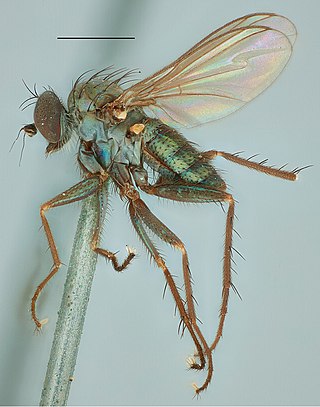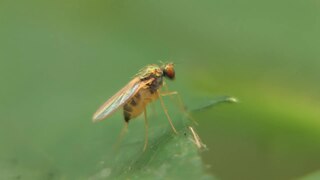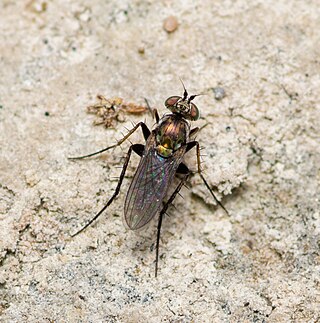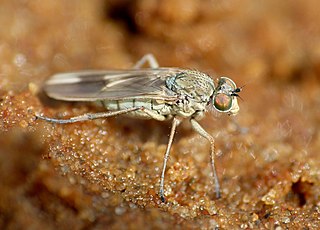Antyx is a genus of flies in the family Dolichopodidae from the Australasian realm. The genus was originally placed in the subfamily Sympycninae, but it was later found to be closer to the Neurigoninae and was placed as incertae sedis within the family. In the World Catalog of Dolichopodidae by Yang et al. (2006), the new subfamily Antyxinae was proposed, in which Antyx is the only genus. However, the validity of this new subfamily was later criticized by Sinclair et al. (2008). According to them, the subfamily's erection by Yang et al. (2006) was not justified by their phylogenetic analysis, and the genus would have been better placed as incertae sedis until a later phylogenetic study determines its placement.

Asyndetus is a genus of flies in the family Dolichopodidae. There are more than 100 species described for the genus, distributed worldwide.
Ceratopos is a genus of flies in the family Dolichopodidae, known from Algeria and Portugal. It contains only one species, Ceratopos seguyi. It is closely related to Syntormon, and is considered a junior synonym of it according to Evenhuis & Bickel (2022).

Chrysotimus is a genus of longlegged flies in the family Dolichopodidae. It is cosmopolitan in distribution, but it is probably paraphyletic with respect to several genera of limited distribution.
Cymatopus is a genus of flies in the family Dolichopodidae. Members of the genus are found on rocky coasts of the Indo-West Pacific.

Lichtwardtia is a genus of flies in the family Dolichopodidae. It is known from the Afrotropical, Oriental and Australasian realms. It can be recognised by its zigzag-shaped M vein on the wings, and its feather-like hairs on the apex segment of the antennae. In a phylogenetic analysis of the subfamily Dolichopodinae by Scott E. Brooks in 2005, Lichtwardtia is considered to be a synonym of Dolichopus, but subsequent authors have retained it as a valid genus.

Medetera is a large genus of flies in the family Dolichopodidae. It includes about 350 species worldwide. The adults are commonly found resting on vertical surfaces such as tree trunks, on which they have a characteristic vertical upright stance. Because of this stance, they are sometimes known as "woodpecker flies". Medetera adults are predators of soft-bodied arthropods, while the larvae are predators of bark beetle larvae.
Micromorphus is a genus of flies in the family Dolichopodidae.

Paraclius is a genus of flies in the family Dolichopodidae. It is currently considered a polyphyletic assemblage of species.
Plagiozopelma is a genus of flies in the family Dolichopodidae.

Thinophilus is a genus of flies in the family Dolichopodidae. It includes about 146 described species distributed worldwide. Most species of the genus are found in coastal habitats, while a few species are found in freshwater habitats.

Hydrophorinae is a subfamily of flies in the family Dolichopodidae. Several molecular phylogenetic analyses of the family have found evidence that the subfamily in its current sense is polyphyletic.

Dolichopodinae is a subfamily of flies in the family Dolichopodidae.

Peloropeodinae is a subfamily of flies in the family Dolichopodidae. In some classifications, the genera of the subfamily are included in Sympycninae. According to a molecular phylogenetic analysis of the family Dolichopodidae by Germann et al. (2011), the subfamily is polyphyletic.
Conchopus is a genus of flies in the family Dolichopodidae. It is distributed in Japan, China, Taiwan, the Hawaiian Islands, and Wake Island. The species Conchopus borealis is also an introduced species in North America and South America. Members of the genus live exclusively in the intertidal zone of rocky shores. The genus is sometimes considered a synonym of Thambemyia, but is considered a valid genus by some authors.

Scorpiurus aramoana is a species of fly in the family Dolichopodidae. It is endemic to New Zealand. The species was first discovered in December 2017 on the saltmarsh mudflats of Aramoana near Dunedin in the South Island of New Zealand, and later found further south in the Catlins.

Stephen Ernest Thorpe was an English-born New Zealand entomologist who contributed vast amounts of data and analysis in many contexts, particularly to iNaturalist.
Scorpiurus thorpei is a species of fly belonging to the family Dolichopodidae. First described by Kazuhiro Masunaga in 2017, it is endemic to New Zealand.











